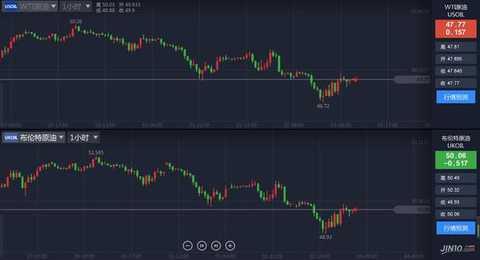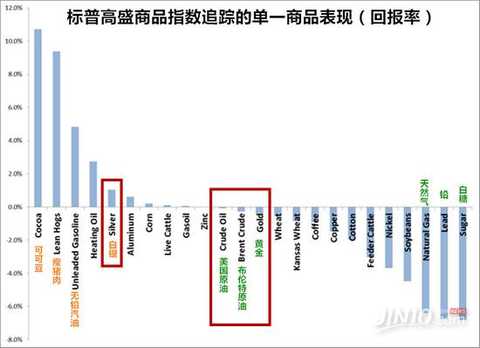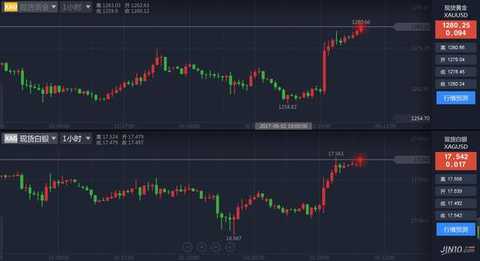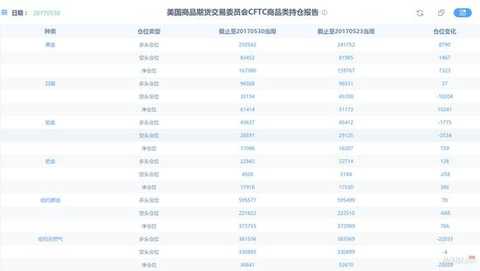Last week, the oil market was still dominated by short positions. The continued growth of US crude oil production and the negative news of Trump's withdrawal from the Paris Climate Agreement prompted oil prices to hit a three-week low, falling more than 4% for the week; precious metals, due to May non- Agriculture broke out of the big upset, and gold hit the highest closing price in more than a month. · Crude oil futures prices closed down about 1.5% last Friday, and the cumulative decline over the entire week exceeded 4% · EIA crude oil inventories and gasoline inventories both fell, but US crude oil production and drilling numbers continued to rise · CFTC shows a sharp decline in net long position growth of crude oil · Natural gas futures prices fell more than 9% · Gold futures prices rose for four weeks, with a cumulative increase of 1% a week · Non-agricultural use increased by 138,000 in May, far less than expected · London’s terrorist attacks have raised the risk aversion again, and the UK’s elections became the focus this Thursday. Energy goods Last Friday (June 2), as US crude oil production and active drilling continued to grow, US President Trump announced his withdrawal from the Paris Climate Agreement to deepen market concerns about oversupply, and Reuters survey showed OPEC in May. Crude oil production rose for the first time in the year, crude oil futures prices closed down, hitting the lowest closing price in more than three weeks, and also hit the biggest one-week drop in a month in the overall transaction last week. Specific data showed that the WTI crude oil futures for July delivery on the New York Mercantile Exchange fell 70 cents, or 1.5%, to close at 47.66 US dollars per barrel, setting the lowest closing price since May 10. The contract fell 4.3% last week, the biggest weekly decline since the week ending May 5. Brent crude oil futures for July delivery on the ICE European Futures Exchange also fell 68 cents, or 1.3%, to close at $49.95 a barrel, down by about 4.9% in a single week. In fact, since the end of the OPEC meeting in late May, there has been no significant positive news in the market. First, the US Energy Information Administration (EIA) data showed that US crude oil inventories fell for 8 weeks, a decrease of 6.428 million barrels, the largest decline since December 30 last year, gasoline inventory. After falling for four consecutive weeks, gasoline demand increased to a record high; afterwards, some sources said that OPEC or re-discussed the expansion of production by 1%-1.5% when necessary, Saudi Energy Minister Falih also stated that he would At the July meeting, it was assessed whether further production cuts were needed. However, Schneider Electric commodity analyst Robbie Fraser said that the good news of EIA "is offset by the continued rise in US crude oil production and the sharp increase in refining activities." Rosneft CEO Shelchin also said that US crude oil production will increase by 1.5 million barrels per day next year. In addition, the oil service company Baker Hughes data also showed that the number of US oil drilling increased by 11 to 733, rising for the 20th consecutive week; and Trump's announcement of the withdrawal of the Paris Climate Agreement also worried the market will stimulate shale The exploitation of oil has triggered a knee-jerk reaction to oil prices. On the other hand, Reuters last week's survey showed that although OPEC's implementation rate of production cut last month increased from 90% to 95%, due to increased production in Nigeria and Libya, the organization's May crude oil production increased by 250,000 barrels per day to 32.22 million barrels. /Day, for the first time of the year, the survey showed a monthly increase. The oil market has seen a lot of sentiment more than the previous week. The latest CFTC position report shows that as of the week of May 30 (OPEC decided to extend production cuts), speculative net long position of crude oil increased by 766 contracts to 373,755 contracts, an increase for the third consecutive week, but the increase was 44,037 contracts over the previous week. There has been a sharp decline. Precious metal Last week, as the US non-farm payrolls report in May fell sharply less than expected, the market worried about the prospect of the Fed raising interest rates for the rest of the year. Gold futures prices closed higher on Friday (June 2), the highest closing since April. The price rose for the fourth consecutive week. Gold futures for August delivery on the New York Mercantile Exchange rose $10.10, or 0.8%, to close at $1,280.20 per ounce. According to the main contract, gold futures hit the highest closing price since April 21, and it has risen by about 1% in this week's overall transaction. According to data released by the US Department of Labor on Friday night, the US non-farm payroll population increased by only 138,000 in May, far lower than the expected 185,000, the second-lowest record since October last year. Most of the other details of the report were not as expected. In March and April, the number of new non-agricultural employment was revised from 79,000 and 211,000 to 50,000 and 174,000 respectively. The market focused on the average hourly rate in May. The annual salary rate also remained at the lowest level of 2.5% since March last year. Despite this, the CME "Fed Observation Tool" still shows that the probability of a Fed rate hike in June is as high as 94.5%. However, the prospect of interest rate hikes after this is not so clear. Goldman Sachs delayed the third rate hike in the year from September to December after the non-agricultural data was released. The current market bullish gold sentiment is unusually high. The latest CFTC position report shows that as of the week of May 30, COMEX gold net long position increased by 7323 hands to 167,090 hands, for the second consecutive week of overweight. The Kitco weekly gold survey also showed that 80% of the 12 Wall Street traders and analysts interviewed said that gold will continue to rise this week, and 20% believe that gold will consolidate and no one is bearish. For other precious metals, silver futures for July delivery rose 24.4 cents, or 1.4%, to close at $17.525 per ounce, or 1.4%, and rose about 1.2% this week. The S&P Goldman Sachs Commodity Yield Index shows that the cumulative return on silver last month was about 1.5%, far exceeding that of gold and crude oil. On Thursday, former US Federal Bureau of Investigation (FBI) director James Comey will go to the Senate Intelligence Committee to testify that his highly publicized fabric will interact with President Trump in the past few months. The situation provides clues. The hearing is likely to shift the focus of the market to the impact of the Trump scandal. Previously, Trump's "Leak Door" boosted gold to break through the 1260 mark. The London terrorist attacks on the weekend also caused the market risk aversion to heat up quickly. Spot gold broke through the 1280 mark on Monday. On Saturday night local time, a truck suddenly crashed into the pedestrian on the London Bridge. The attacker then jumped out of the car and used a knife to attack. Almost at the same time, the attackers rushed into a bar in the Borough Market near London Bridge with a knife. The incident has caused at least 7 deaths, 48 ​​injuries, and 3 attackers were killed by the police on the spot. The incident also brought the UK elections next Thursday back into focus. Some analysts said that the successive terrorist attacks have pressured and added to the British Prime Minister Teresa May, and his re-election as prime minister is no longer a winner. However, whether Teresa or Corbin won the general election on June 8, the terrorist attacks have deeply imprinted the future policy direction of the UK. (Editor: Wu Xiaolin HF106) Cotton Woven Fabric,Woven Stripe Fabric,Cotton Woven Printed Fabric,Lightweight Woven Cotton Shaoxing Musa Imp & Exp Co., Ltd. , https://www.musa-textile.com

In other energy commodities, natural gas futures for July delivery closed at $2.999 per million British thermal units, and for the first time since mid-March, it closed below $3, and fell 9.4 in last week's trading. %about. Of the 24 commodities tracked by the S&P Goldman Sachs Commodity Yield Index, natural gas was the biggest loser last month, with a cumulative return of -6.4%. 

